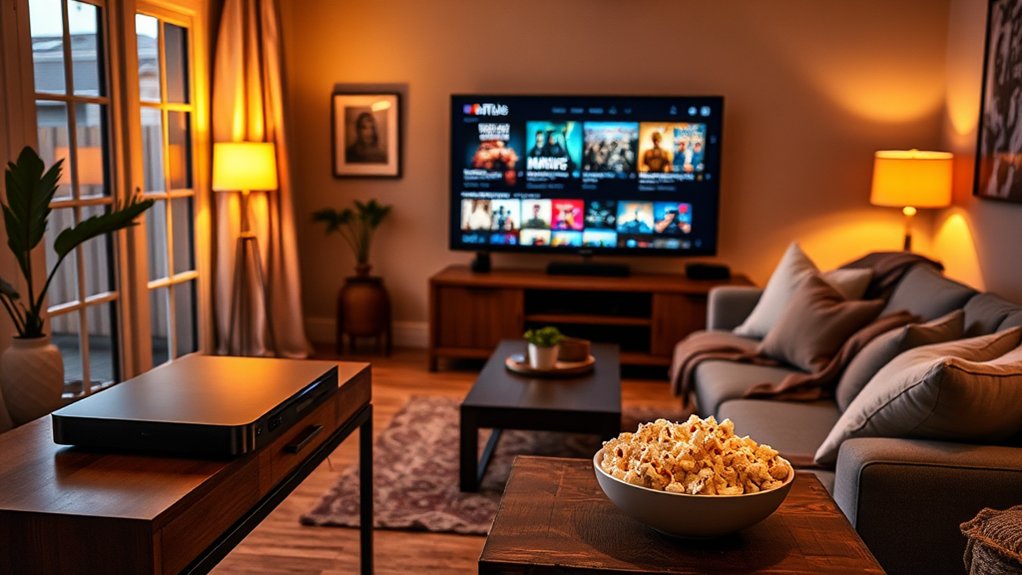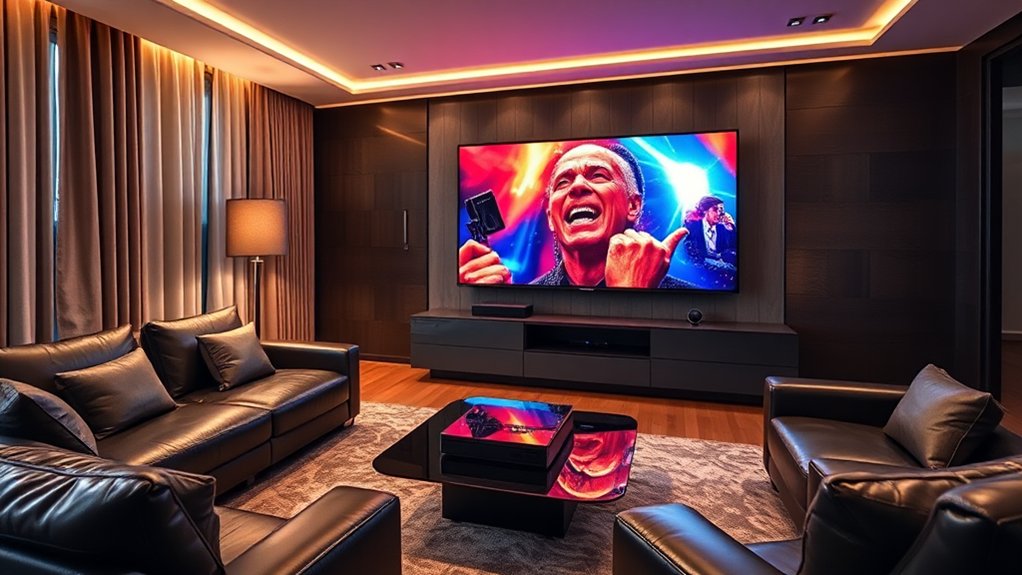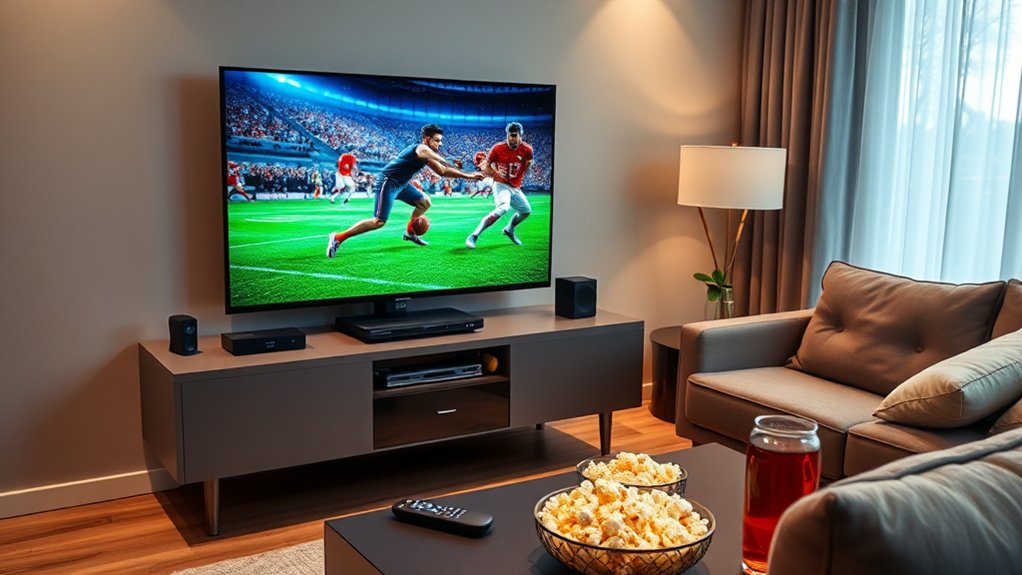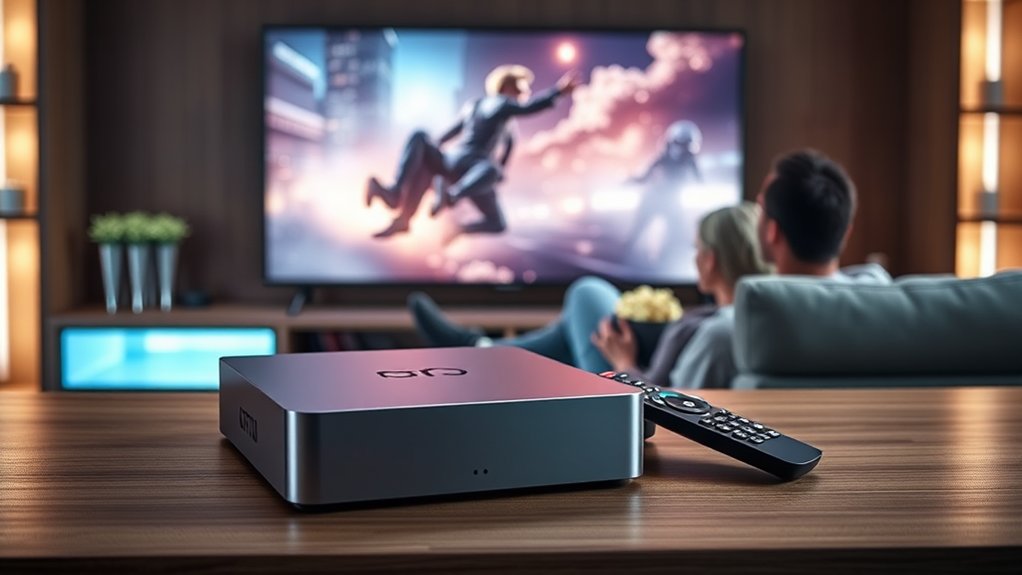To set up a simple home theater streaming device, start by choosing a compatible device like Roku or Apple TV 4K, ensuring it supports your preferred streaming services. Connect it using quality HDMI cables and arrange your audio components for ideal sound. Next, optimize your network for speed—wired is best. Finally, tweak your audio and video settings for a sharp picture and rich sound. If you’re wondering about advanced features, stick around for more insights!
Key Highlights
- Choose a compatible streaming device, like Roku or Apple TV 4K, that supports your desired features and fits your budget.
- Connect the device using high-quality HDMI cables, ensuring power is off before setup and implementing neat cable management.
- Configure a wired Ethernet connection for optimal internet speed, or place your router centrally for effective Wi-Fi coverage.
- Position speakers for balanced audio, calibrate levels with an SPL meter, and adjust settings for optimal sound and video quality.
- Organize your media library with consistent naming conventions and logical folder structures for easy access to content.
Choosing the Right Streaming Device
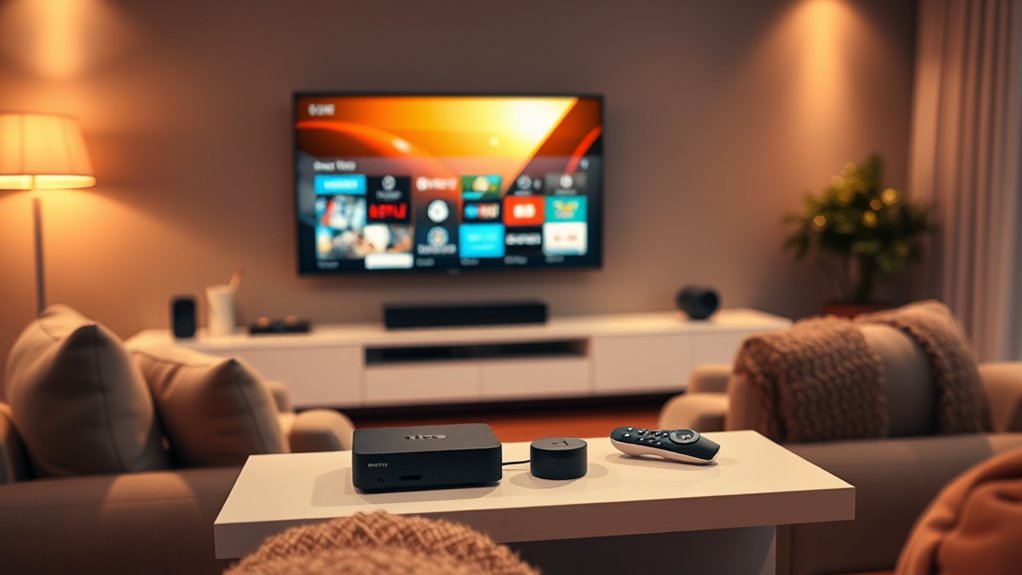
As for picking the right streaming device, what factors should you really consider?
First, think compatibility—does it work smoothly with your smartphone or tablet? For instance, if you’re an iOS user, Apple TV might just be your best buddy.
Consider compatibility first—ensure your streaming device syncs well with your smartphone or tablet for seamless enjoyment.
Next, evaluate the ecosystem; devices like Android TV come with built-in apps for easy rentals or purchases. Additionally, ensure that your streaming device allows for optimal speaker placement to maximize your audio experience. Certain models, such as the Samsung HW-Q990C, provide excellent compatibility with high-performing soundbars.
Then, look into performance features, such as whether you want 4K HDR support for a stunning viewing experience. Many streaming devices also support modern audio formats like Dolby Atmos, which can greatly enhance your viewing experience.
And don’t forget about the user interface—no one enjoys a clunky menu!
Finally, balance those features with your budget. Are you spending more for capabilities you won’t use?
After all, choosing the right device shouldn’t feel like rocket science, right?
Setting Up Hardware Connections
Setting up hardware connections for your home theater isn’t just about plugging things in—it’s a mini-project that, when done right, can improve your viewing experience substantially.
Start by labeling all cables and speaker wires; trust me, future changes will thank you. Before diving in, take a moment to skim through your receiver’s quick-start guide.
Gather your tools, like a wire stripper and a laptop for instructions, then arrange your components—TV, receiver, speakers, and streaming device—within reach. Use HDMI cables for direct connections, opting for quality like HDMI 2.0 or 2.1. Sound quality is essential for an immersive viewing experience, so choosing the right audio setup is crucial. For instance, soundbars like the Sonos Beam can enhance both music and movie experiences in compact spaces. Make sure to invest in a quality power protection device for your components to ensure their performance and longevity.
Neat cable management matters, so plan routes to avoid tangles, and remember to power down everything before connecting to skip any electrical mishaps.
Ready to get started?
Configuring Network and Streaming Services
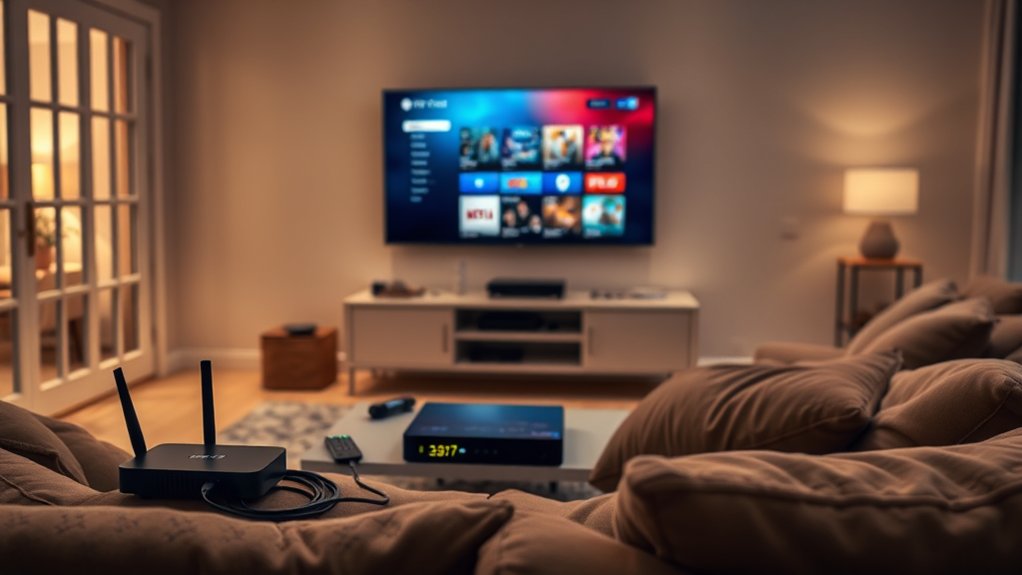
When you’re ready to plunge into configuring your network and streaming services, it’s crucial to understand that this step isn’t just a checkbox on your installation list; it’s the backbone of your home theater experience.
First, try using a wired Ethernet connection—it’s like having your internet on steroids, especially for 4K content. If you must use Wi-Fi, place your router centrally to maximize coverage. To optimize your network setup, consider using a patch panel to simplify cable management and ensure organized connections.
Make certain all devices are compatible and have updated firmware. Once you connect your streaming device, set up your accounts with platforms like Netflix and adjust video quality settings according to your bandwidth.
Don’t forget to test everything after setup; nobody wants buffering during movie night, right? So, get started!
Optimizing Home Theater Audio/Video Settings
To truly improve your home theater experience, diving into the art and science of audio and video settings is key—after all, what’s a great movie without a fantastic sound to match?
Start by positioning your front speakers equidistant from your seating area, angling them slightly for that perfect stereo image. Experiment with subwoofer placement; sometimes, a corner works wonders for bass.
Use an SPL meter for accurate speaker level calibration, confirming they reach you simultaneously, just like a well-timed cinematic climax. Don’t forget room acoustics—add sound-absorbing panels and avoid large reflective surfaces for clearer sound.
Additionally, integrating Dolby Atmos technology can enhance your overall audio experience, allowing sound to move freely in a three-dimensional space. Finally, tweak your equalizer to balance those tricky frequencies, making certain no single sound overwhelms the others. Happy viewing!
User Interface and Remote Control Setup

A great audio-visual experience often needs the right user interface and remote control setup to match, as how you interact with your devices can greatly impact your enjoyment.
Begin by programming a universal remote that can smoothly control multiple devices, like your streaming box and TV—who wouldn’t want to eliminate extra remotes cluttering the coffee table? You can create custom activities that power on everything with one button press, like magic!
On the other hand, consider using a companion app on your smartphone or tablet; it’s like having a remote that never gets lost (unless you misplace your phone!). Just sync it to your Wi-Fi, and you’re set—easy navigation, voice commands, and even tactile feedback significantly improve your streaming experience dramatically. Additionally, pairing your setup with advanced soundbar features can further enhance the overall audio quality and integration with your devices.
Personalizing Your Streaming Experience
Personalizing your streaming experience is essential to making every movie night or binge-watching session truly enjoyable, as the right settings and features can transform how you engage with content.
Start by prioritizing devices that support 4K HDR, Dolby Vision, and Dolby Atmos for stunning visuals and immersive sound, making you feel like you’re part of the action.
Don’t overlook personalized profiles for family members—recommendations tailored to individual tastes can prevent those awkward moments when someone else wants to watch something completely different.
Plus, investigate the app library to guarantee your favorite streaming services and niche apps are at your fingertips.
Finally, tweak settings like brightness and sound to match your unique viewing preferences; after all, comfort is key! Additionally, consider integrating devices like the Sonos Arc Ultra for an unparalleled audio experience that makes every soundscape resonate beautifully.
Maintenance and Troubleshooting Tips
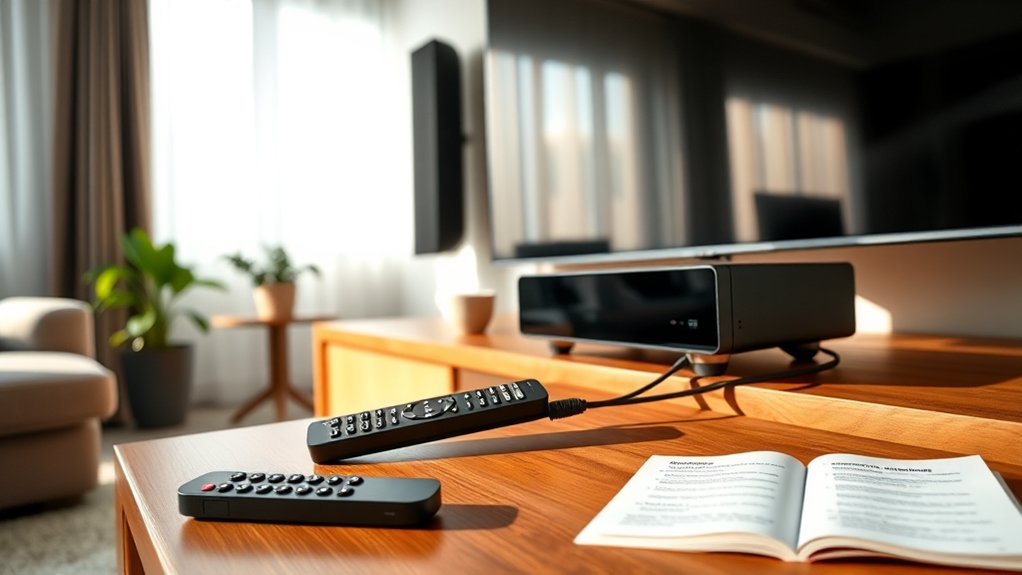
Even though it’s easy to get swept up in the excitement of setting up your home theater, proper maintenance and troubleshooting are vital for keeping the experience seamless and enjoyable.
Start by unplugging your devices before cleaning; a soft microfiber cloth works wonders on screens and panels, preventing scratches. Remember to check and clean projector filters monthly to avoid performance issues.
Regularly inspect cables and secure any loose connections, as nobody wants their movie interrupted by a sudden audio drop. Finally, keep software and firmware updated to improve performance and tackle bugs.
A bit of upkeep can go a long way—after all, who wouldn’t prefer smooth streaming over constant fussing with technology? Additionally, considering the number of drivers in your soundbar can significantly impact overall sound quality.
Enhancing Your Media Library
In the domain of enhancing your media library, you’ll want to guarantee that everything is organized and easily accessible, so you’re not sifting through endless files in a panicked search for that one classic you’d in mind.
Start by conducting a thorough content audit to identify all your media files. Establish a consistent naming convention, maybe something like “Movie_Title_Year_Genre.”
Conduct a content audit to identify your media files and create a consistent naming convention for easy organization.
Next, categorize your content into logical folders—movies, TV shows, music, you get the idea.
If multiple users are involved, assign roles for media management to avoid filing conflicts. Don’t forget to schedule regular reviews to keep your library fresh, removing duplicates and archiving outdated content.
An organized library means quick access and more time enjoying your favorites.
Exploring Additional Features and Compatibility
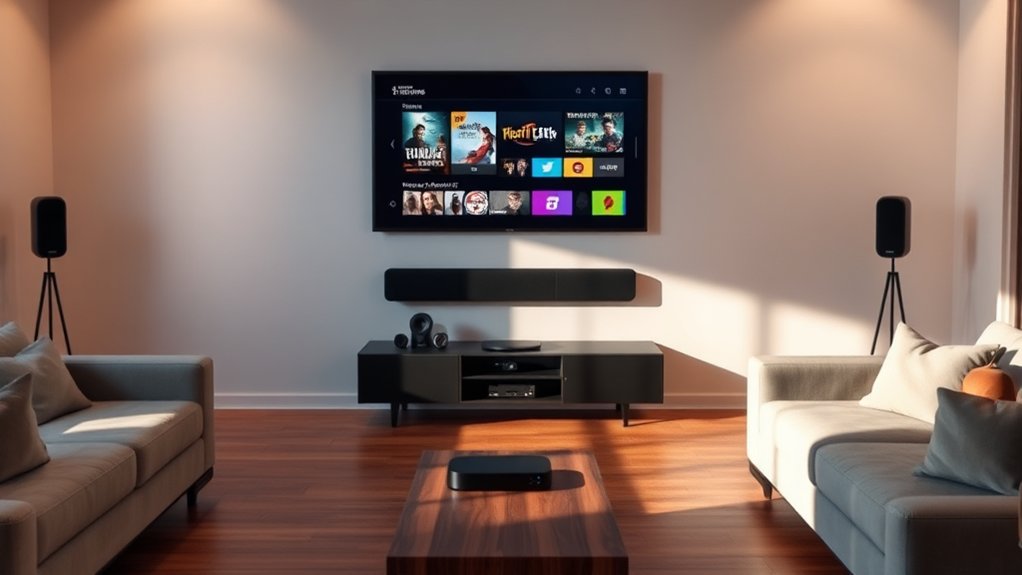
When setting up your home theater, compatibility and additional features of your streaming device can make all the difference. You’ll want a device like Roku or Apple TV 4K, which typically support major platforms like Netflix and Hulu.
Don’t forget to check if your device handles surround sound formats—do you really want to miss out on that juicy Dolby Atmos experience? Furthermore, HDMI connections are a must for high-quality audio and video, whereas Bluetooth support can provide wireless listening options.
And if you like to control everything with your voice, consider devices that integrate with smart home assistants. After all, who wouldn’t want to command their system like a movie wizard? Additionally, ensuring your streaming device is compatible with HDMI ARC technology can greatly enhance your audio setup and simplify connections within your home theater system.
Frequently Asked Questions
Can I Use Multiple Streaming Devices on One TV?
Yes, you can use multiple streaming devices on one TV. Just connect them through available HDMI ports, and switch inputs as needed. It simplifies access to different platforms without the hassle of constant logins.
How Do I Reset My Streaming Device to Factory Settings?
To reset your streaming device to factory settings, navigate to the settings menu, select “System” or “General,” find the “Reset” option, and confirm your choice to erase all data and restore original settings.
Are Streaming Devices Portable for Travel Use?
Yes, streaming devices are portable and perfect for travel. Their compact size makes them easy to carry, fitting into luggage effortlessly, and they connect to most TVs via HDMI, ensuring you can enjoy entertainment wherever you go.
What Can I Do if My Remote Stops Working?
If your remote stops working, check the batteries first. Make certain they’re fresh and correctly placed. If that doesn’t help, try resetting it and re-pairing it with your streaming device.
How Do I Customize Subtitles and Captions Settings?
To customize your subtitles and captions settings, start playback, access the Audio & Subtitles menu, and select your preferences. You can adjust font size, color, and background for better visibility based on your needs.

